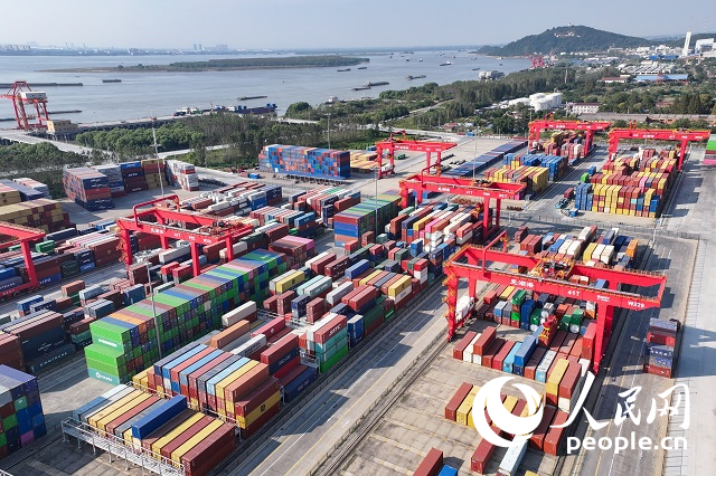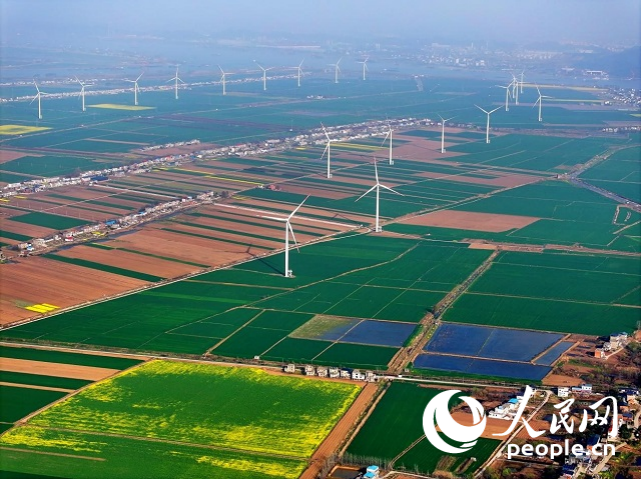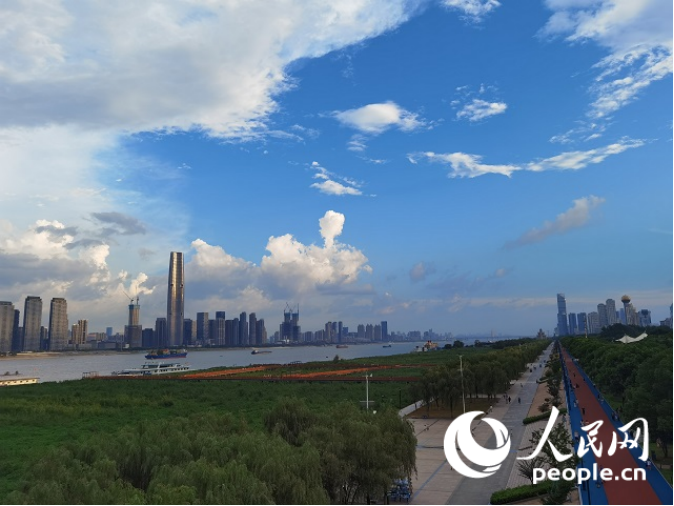Joint Reporting Team of People’s Daily Online
China is sounding a new clarion call for the rise of its central region.
On the afternoon of March 20, General Secretary Xi Jinping chaired a symposium on energizing the central region in the new era in Changsha City, Hunan Province. He delivered an important speech, calling on for concrete steps to propel the rise of the central region at a higher starting point.
After nearly five years, Xi once again held a symposium on the future development of the central region, pointing out the way forward for the rise of the region on the new journey.
The six provinces in the central region, by transforming their regional advantages into development advantages, have striven to integrate into and support the new pattern of development, develop themselves into new pacesetters for opening up in the inland region with enhanced competitiveness, and make the central region more beautiful and stronger.
From regional advantages to development advantages
Better integrating into and supporting the new pattern of development
Located in the hinterland of China, the central region borders many provinces, with the Yangtze River and Yellow River running through it. As a comprehensive transportation hub with convenient water, land and air transportation, how can the central regional transform its regional advantages into development advantages?
Anhui Province turns its attention to building the “water highways”. Within the territory of Anhui, the Yangtze River is just about 300 kilometers from the Huaihe River as the crow flies. However, in the past, the watershed between the two rivers prevented them from connecting to each other for thousands of years. Thanks to the full operation of the Yangtze-Huaihe Canal in September 2023, industrial enterprises have more options to exchange goods with regions along the rivers. The canal helps reduce logistics costs by about 5% to 10% and increase corporate profits by 1.6 percentage points.

The bustling Wuhu Port in Anhui Province. (Photo by: Li Ximeng, reporter from People’s Daily Online)
Henan Jinshan Chemical Group also benefits from the operation of the Yangtze-Huaihe Canal. As a chemical enterprise adopting the combined-soda process, Jinshan supplies raw materials to photovoltaic glass enterprises in Wuhu, whose cargo ships often travel between Zhoukou of Henan Province and Wuhu.
“We need to transport 140,000 tons of raw materials with 70 to 80 ships each month. In the past, the total shipping distance was over 800 kilometers. Thanks to the canal, the shipping distance is reduced by over 370 kilometers, saving four or five days of shipping time.” According to the calculation of Yang Tao, logistics manager of Jinshan, the company can save transportation costs of nearly RMB10 million in a year.
With the smooth operation of the canal, the advantages of the central region become more prominent. In Anhui, the Yangtze-Huaihe Canal has not only reshaped the shipping pattern in the province, but also strengthened the connection between the Yangtze River Delta and the Central Plains, becoming a key channel for the circulation of economic elements in the three major river basins of the Yangtze River, Huaihe River and Yellow River. In Hubei, comprehensive transportation hubs such as the Yangtze River golden waterway, air hub, high-speed rail artery and major high-speed channel are gradually taking shape. In Henan, on the bustling air, land, internet and maritime “Silk Roads”, we see a constant flow of people, goods, technologies and information. The four silk roads form a dense network, connecting inland Henan Province to the world...
To transform regional advantages into development advantages, the central region has made great efforts to absorb relocated industries in stages and in order and refine industrial layout.
Located in the mountainous area of northwest Hubei Province, Zhushan County once had a weak industrial foundation. In early 2020, word came that sanitary ware enterprises in developed areas along the southeastern coast encountered recruitment problems, and it was imperative to relocate industries. The news was mind-blowing for officials in Zhushan County. The county organized special leading groups to make over 20 trips to inspect sanitary ware enterprises in other provinces and attract investment. They successively engaged with enterprises from Wenling of Zhejiang Province and Nan’an of Fujian Province. In February 2022, the Baofeng Sanitary Ware Industrial Park in Zhushan County was included in the first batch of demonstration parks to absorb relocated industries in Hubei Province. The sanitary ware industry has emerged as a pillar industry in Zhushan and initially formed industrial chains.
“The central region boasts a unique geographical location. With the improvement of the business environment and gradual elimination of market barriers in recent years, the six provinces usher in greater development opportunities. We see greater connectivity between the region and the Beijing-Tianjin-Hebei region, the Yangtze River Delta, the Greater Bay Area and Chengdu-Chongqing economic zone. In the past, we focused on the collaboration between the six provinces; at present, we further emphasize their alignment with other major development strategies, which will enable them to unite as one and seek external cooperation,” said Wang Lei, deputy head of the Institute of Central China Development, Wuhan University.
From a central hinterland to a pacesetter for opening up
Striving to connect domestic and international economic flows
Adjacent to neither seas nor national boundaries, how can the central region develop itself into an inland pacesetter for opening up?
The six provinces have given their answer: by virtue of the Land Silk Road and the Air Silk Road.

On March 21, containers loaded with compound fertilizer were transported to the customs supervision area of Huaihua International Land Port. The goods would be exported to Vientiane, Laos.
(Photo by: Lei Mingxiong)
On March 21, in the warm sun, the LCL center of Huaihua International Land Port in Hunan Province was bustling with people. 210 tons of compound fertilizer transported from Ordos, Inner Mongolia just arrived at the port. Yang Linlin, an employee of Honest Global Logistics, a freight forwarder, was busy coordinating stevedores to load the containers. After passing safety inspection, the goods would be transferred to the customs supervision area and then sent to Vientiane of Laos.
On the same day, large trucks with license plates of different provinces gathered in the customs supervision area of the Container Center Station of Zhengzhou Railway. Goods from all over China would, after customs clearance, be exported to Europe and other places via Henan China-Europe freight trains on the Land Silk Road.
On March 16, 24 European tourists took flight CZ678, heading from Luxembourg to Zhengzhou of Henan Province through the Zhengzhou-Luxembourg Air Silk Road. 20 tourist groups will successively arrive in Henan in the near future.
The central region has refined its policies and mechanisms for opening up and accelerated its integration into the global market.

Ezhou Huahu Airport in Hubei.
(Photo credit: Publicity Department of Ezhou Municipal Party Committee)
The smooth operation of the air gateway could not do without the improvement of the business environment. On April 1, 2023, the first international freight route of Ezhou Huahu Airport in Hubei was launched. Wuhan Customs, based on the characteristics of the airport, customized a supervision model and implemented a series of measures to facilitate customs clearance, such as direct goods pickup and transfer at the apron, domestic continued operation, advance declaration and customs clearance appointment, so that international goods can be picked up and loaded upon arrival around the clock.
By strengthening transportation hubs, upgrading port platforms, developing multimodal transport and improving the business environment, the provinces in the central region have pursued progress while ensuring stability and accelerated the formation of a new pattern of all-round, high-level opening up.
From resource dependence to green and low carbon growth
Pursuing green development to build a beautiful central region
The central region is an important base of energy and raw materials in China. In the past, traditional industries such as steel, coal and non-ferrous metal played an important part in the industrial systems of the six provinces, putting them under great resources and environmental pressure. So, how to build a beautiful central region featuring harmony between humanity and nature?
Shanxi Province, as the former leading coal producer, is determined to be the vanguard of the energy revolution.
Coking has been one of the pillar industries in Taiyuan, Shanxi. However, the extensive development model has resulted in prominent ecological problems. Shutdown and phase-out can only achieve capacity replacement. Green development is the ultimate goal in industrial transformation and development. So, how to achieve green development? Qingxu Economic Development Zone in Taiyuan gave its answer: connecting initial and end processes, fully utilizing resources, and urging enterprises to realize small cycles so as to form large cycles in industrial parks. Specifically, coke gas will be transported through pipelines to the high-purity hydrogen project base of Shanxi Meijin Energy to produce hydrogen fuel; coal tar will be transported to Gengyang Group and processed into high-end carbon materials; crude benzene will be transported to industrial parks of Taihua New Materials subordinate to Lu’an Chemical Group, to produce PA6 and other new chemical material products... “The coke chemical industry, basic chemical industry, fine chemical industry and daily chemical industry are sustained and expanded,” said Si Huizhu, Director of the Law Enforcement Bureau of Qingxu Economic Development Zone.
Resource conservation, intensive utilization and recycling have injected more “green power” into the rise of the central region. Green electricity becomes an imperative for more and more provinces, cities, and traditional enterprises with high energy consumption and pollution.

Wind turbines along the Yangtze River in Jiangzhou Town, Chaisang District, Jiujiang City of Jiangxi Province. (Photo by: Zhu Haipeng from People’s Daily Online)
“The wind farm in Jiangzhou generates about 190 million kWh of electricity. The green electricity will be transmitted to the national grid and supplied to various places.” Wang Xudong, leader of the wind farm O&M team in Jiangzhou, pointed to the rotating wind turbines in the distance. Relying on the rich wind resources of rivers, lakes and mountains, Jiangxi has vigorously developed the wind power industry and promoted energy conservation, consumption reduction, low-carbon development, and emission reduction, transforming clean energy advantages into economic advantages.
In Lushan County of Henan Province, Dadi Cement Group set up 100,000 photovoltaic panels on barren mountains. While achieving electricity self-sufficiency in cement production, the group trades carbon surplus on the carbon trading market.
The central region has attached equal importance to subtractions and additions.
Hunan Province has refined the statistical accounting system for greenhouse gas emissions, so as to do a good job in the carbon emission data accounting, report verification, quota allocation and quota settlement of key industries and enterprises.
Jiangxi Province has stepped up the improvement of the water environment of the Yangtze River Basin and the Poyang Lake Basin and made concerted efforts to safeguard ecological security, in a bid to consolidate the gains of the ten-year fishing ban.
Hubei Province has renovated 10,742 sewage outlets of the Yangtze River. 17 cities and prefectures across the province have established horizontal ecological compensation mechanisms for basins. 11 cross-city horizontal ecological compensation agreements have been signed for such important basins as the Yangtze River, Qingjiang River, Sihu Basin and Tongshun River. The province has also facilitated inter-provincial collaboration and signed inter-provincial basin compensation agreements with Hunan and Jiangxi.
...

The beach park in the Wuhan section of the Yangtze River in Hubei Province is lush with greenery.
(Photo by: Zhou Wen, reporter from People’s Daily Online)
Thanks to the collaboration of multiple parties, the ecological environment of the Yangtze River has seen steady improvement. On the morning of March 14, in the Shuangliu section of the Yangtze River, Xu Jianli, an environmental protection volunteer from Xinzhou District of Wuhan, sighted finless porpoise again. The once endangered species has been frequently sighted there.
Five years ago, General Secretary Xi Jinping chaired a symposium on energizing the central region in Nanchang City, Jiangxi Province, drawing up an inspiring blueprint for opening up a new vista in the rise of the central region.
In the past five years, remarkable achievements have been made. In line with the strategy of coordinated regional development, the central region has injected great impetus into China’s economy.
This time, General Secretary Xi Jinping chaired the symposium on energizing the central region in the new era in Changsha City, Hunan Province, proposing new plans for propelling the rise of the central region at a higher starting point.
The six provinces in the central region will earnestly study the guiding principles of Xi’s important speech, formulate plans adapted to local conditions and implement them across the board, make concrete efforts to energize the central region, and usher in a new chapter in China’s modernization drive.
(Translated by Yu Jie)
